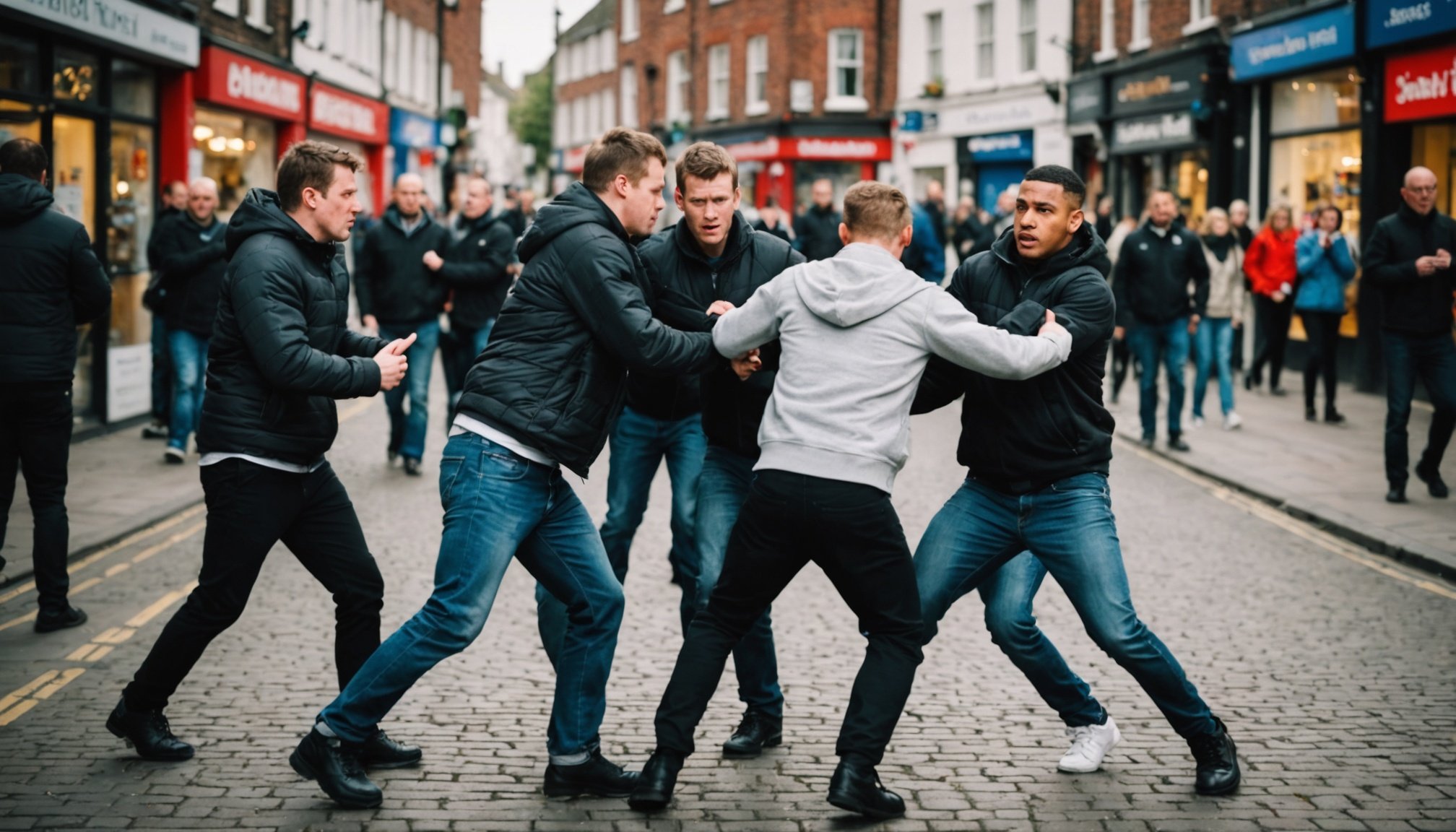Understanding the Legal Consequences of Unauthorized Street Fights in the UK
Unauthorized street fights, often referred to as public order offences, can have severe legal consequences in the UK. These incidents not only disrupt public peace but also pose significant risks to the safety and well-being of individuals and the community at large. Here, we will delve into the specifics of these offences, the legal framework surrounding them, and the potential penalties involved.
What Constitutes a Public Order Offence?
Public order offences encompass a wide range of activities that disturb public peace, safety, or health. These can include anything from minor disturbances to more serious acts of violence.
Also to discover : Top Summer Camps in the UK for Young Fighters to Enhance Their Skills
Types of Public Order Offences
-
Affray: This involves using unlawful violence or threats to cause fear in a member of the public. The penalty for affray can be up to a maximum of 3 years in custody and is triable either way, meaning it can be heard in either the Magistrates’ or Crown Court.
-
Violent Disorder: This is when three or more people are gathered together and threaten or use unlawful violence for a shared purpose against members of the public. The penalty for this offence can be up to a maximum of 5 years in custody.
Also to discover : Exploring the Lasting Physical Impact of Combat Sports Participation in the UK
-
Rioting: This is the most serious form of public disorder, involving 12 or more people gathered together who threaten or use unlawful violence for a shared purpose against members of the public. The penalty for rioting can be up to a maximum of 10 years in custody and is triable on indictment only, meaning it must be heard at the Crown Court.
-
Harassment, Alarm or Distress: This involves verbal threats, verbal abuse, and public displays of offensive or insulting written material. The penalty for these offences can be up to a maximum of 6 months in custody and/or a fine.
Legal Framework and Reporting Requirements
When an unauthorized street fight occurs, it is crucial to understand the legal obligations and the role of the police.
Obligations of Those Involved
In the event of a public order offence, individuals involved must comply with certain legal requirements:
-
Cooperation with Police: If the police are present, individuals must cooperate and provide any requested information. Failure to do so can lead to additional charges.
-
Reporting the Incident: If the police are not present at the scene, those involved must report the incident to the police as soon as reasonably possible, preferably within 24 hours. This is particularly important if there has been any injury or significant damage.
Police Involvement
The police play a critical role in managing and investigating public order offences.
-
Arrest and Charging: The police have the authority to arrest and charge individuals they believe have committed a public order offence. Upon arrest, it is essential to seek legal advice to understand the charges and legal rights.
-
Gathering Evidence: Police officers will gather evidence from the scene, including witness statements and any physical evidence. This evidence is crucial in building a case against those involved.
Penalties and Sentencing
The penalties for public order offences can be severe and are designed to reflect the seriousness of the offence.
Penalties for Different Offences
Here is a detailed list of the potential penalties for various public order offences:
-
Affray:
-
Up to 3 years in custody
-
Fine
-
Both custody and fine
-
Violent Disorder:
-
Up to 5 years in custody
-
Fine
-
Both custody and fine
-
Rioting:
-
Up to 10 years in custody
-
Fine
-
Both custody and fine
-
Harassment, Alarm or Distress:
-
Up to 6 months in custody
-
Fine
-
Both custody and fine
Sentencing Guidelines
The Sentencing Council provides guidelines to ensure consistency in sentencing. Here is a comparison of the sentencing guidelines for different public order offences:
| Offence | Maximum Penalty | Court | Notes |
|---|---|---|---|
| Affray | 3 years in custody | Magistrates’ or Crown Court | Triable either way |
| Violent Disorder | 5 years in custody | Magistrates’ or Crown Court | Triable either way |
| Rioting | 10 years in custody | Crown Court | Triable on indictment only |
| Harassment, Alarm or Distress | 6 months in custody | Magistrates’ Court | Can be heard in Magistrates’ Court |
Community Impact and Legal Guidance
Public order offences not only affect the individuals involved but also have a broader impact on the community.
Community Impact
-
Public Safety: Unauthorized street fights can significantly compromise public safety, causing fear and alarm among bystanders and residents.
-
Economic Impact: Such incidents can also have economic implications, such as damage to property and disruption of local businesses.
Legal Guidance
For those accused of public order offences, seeking legal guidance is crucial.
-
Criminal Defence Solicitors: It is important to have a criminal defence solicitor who can help build a strong case and provide advice on legal rights. Solicitors like those at Garratts Solicitors in Manchester and Oldham specialize in public order offences and can provide 24/7 legal assistance.
-
Understanding Charges: Legal guidance helps individuals understand the charges against them and the potential penalties. This can make a significant difference in the outcome of the case.
Practical Insights and Actionable Advice
Here are some practical insights and actionable advice for individuals who find themselves in situations involving public order offences:
Cooperating with the Police
- Provide Information: If involved in an incident, it is crucial to cooperate with the police and provide any requested information. This can help in resolving the situation quickly and may reduce the likelihood of additional charges.
Seeking Legal Advice
- Immediate Consultation: If arrested or charged, seek legal advice immediately. This can help in understanding the charges and preparing a strong defence.
Avoiding Escalation
- Reasonable Firmness: In situations that could escalate into public order offences, it is important to use reasonable firmness to de-escalate the situation. Avoiding physical confrontations and seeking help from authorities can prevent serious consequences.
Real-Life Examples and Anecdotes
To illustrate the seriousness of public order offences, here are a few real-life examples:
The London Riots of 2011
- The London riots of 2011 were a series of public order offences that resulted in widespread violence, looting, and property damage. The incidents highlighted the severe consequences of such actions, with many individuals receiving lengthy prison sentences.
Recent Court Cases
- In recent years, there have been several high-profile cases involving public order offences. For instance, individuals involved in violent disorder during football matches have received significant prison sentences, emphasizing the seriousness with which the courts treat these offences.
Unauthorized street fights and public order offences are serious matters in the UK, with significant legal consequences. Understanding the legal framework, reporting requirements, and potential penalties is crucial for both individuals and the community. By seeking legal guidance, cooperating with the police, and avoiding escalation, individuals can navigate these situations more effectively.
In the words of a criminal defence solicitor from Garratts Solicitors, “Public order offences can seriously impact an individual’s life. It is essential to have a strong legal defence to ensure the best possible outcome in such cases.”
By being informed and proactive, we can work towards maintaining public order and ensuring the safety and well-being of our communities.











